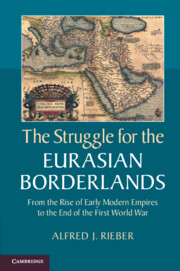 The Struggle for the Eurasian Borderlands
The Struggle for the Eurasian Borderlands Book contents
1 - Imperial space
Published online by Cambridge University Press: 05 June 2014
Summary
The concept of space has become a much disputed topic in the world of scholarship. At one extreme, the “spatial turn” has replaced the physical grounding of geography with symbolic meaning. One result has been a cartography in which space surrenders its independent existence to mental mapping. Terms such as frontiers, borders, boundaries, and place are widely employed to delineate virtually all aspects of culture. Another less radical result has been to repair the long-frayed bonds between geography and history by reintroducing the cultural factor. This is the approach used in this chapter to designate Eurasia, borderlands, and frontiers, the key components of imperial space.
My treatment differs from two widely accepted theoretical approaches: the geopolitical and the civilizational. Both stress a single factor underpinning international politics, whether physical geography or ideology. In practice they come close to endorsing determinism. Both also divide space by static linear borders. By contrast, the present study will interpret Eurasia, its frontiers, and borderlands as spaces shaped by complex historical processes forming a geocultural context in which the great conflicts of the twentieth century will be situated. My preference for the geocultural over the geopolitical and civilizational is also based in part on the fact that the discourses of geopolitics and civilization as applied to Eurasia have been ideologically complicit in the coming of the Cold War.
- Type
- Chapter
- Information
- The Struggle for the Eurasian BorderlandsFrom the Rise of Early Modern Empires to the End of the First World War, pp. 5 - 78Publisher: Cambridge University PressPrint publication year: 2014


